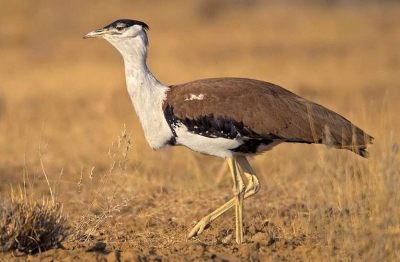
Great Indian bustard, (Ardeotis nigriceps), large bird of the bustard family (Otididae), one of the heaviest flying birds in the world. The great Indian bustard inhabits dry grasslands and scrublands on the Indian subcontinent; its largest populations are found in the Indian state of Rajasthan.
Great Indian bustards are tall birds with long legs and a long neck; the tallest individuals may stand up to 1.2 metres (4 feet) tall. The sexes are roughly the same size, with the largest individuals weighing 15 kg (33 pounds). Males and females are distinguished by the colour of their feathers. Feathers on the top of the head are black in males, which also possess a whitish neck, breast, and underparts, along with brown wings highlighted by black and gray markings. Males also have a small, narrow band of black feathers across the breast. In contrast, females possess a smaller black crown on the top of the head, and the black breast band is either discontinuous or absent.
Great Indian bustards are omnivores that feed opportunistically; that is, they feed on any palatable food in their immediate surroundings. They prey on various arthropods, worms, small mammals, and small reptiles. Insects such as locusts, crickets, and beetles make up the bulk of their diet during the summer monsoon, when rainfall peaks in India and the bird’s breeding season largely takes place. Seeds (including wheat and peanuts [groundnuts; Arachis hypogaea]), in contrast, make up the largest portions of the diet during the coldest and driest months of the year.
Adult great Indian bustards have few natural enemies, but they display considerable agitation around certain predatory birds, such as eagles and Egyptian vultures (Neophron percnopterus). The only animals that have been observed to attack them are gray wolves (Canis lupus). On the other hand, chicks may be preyed upon by felines, jackals, and feral dogs. Eggs are sometimes stolen from nests by foxes, mongooses, monitor lizards, and Egyptian vultures and other birds. The greatest threat to the eggs, however, comes from grazing cows that often trample them.
Credit : Britannica
Picture Credit : Google




